1. A switch is participating in a VTP domain and configured as a VTP server. The switch needs to propagate VLAN 10 (used by the Manufacturing department) throughout the VTP domain, but does not have any directly connected hosts using that particular VLAN. Which configuration would satisfy this requirement?
- interface fa0/24
switchport mode access
switchport access vlan 10 - vlan 10
name Manufacturing
exit - vtp mode server
vtp password Manufacturing - interface g0/1
switchport mode trunk
switchport trunk native vlan 10
2. Which command should the network administrator implement to prevent the transfer of DTP frames between a Cisco switch and a non-Cisco switch?
- S1(config-if)# switchport mode trunk
- S1(config-if)# switchport trunk allowed vlan none
- S1(config-if)# switchport mode dynamic desirable
- S1(config-if)# switchport mode access
- S1(config-if)# switchport nonegotiate
3. While configuring inter-VLAN routing on a multilayer switch, a network administrator issues the no switchport command on an interface that is connected to another switch. What is the purpose of this command?
- to create a switched virtual interface
- to create a routed port for a single network
- to provide a static trunk link
- to provide an access link that tags VLAN traffic
4. What happens to switch ports after the VLAN to which they are assigned is deleted?
- The ports are placed in trunk mode.
- The ports are assigned to VLAN1, the default VLAN.
- The ports stop communicating with the attached devices.
- The ports are disabled.
5. Given the following configuration, which two statements are true? (Choose two.)
switch(vlan)# vtp version 2
switch(vlan)# vtp mode server
switch(vlan)# vtp domain Cisco
switch(vlan)# vtp password mypassword
- This switch can advertise its VLAN configuration to other switches in the Cisco domain only, but can receive advertisements from other domains.
- This switch maintains a full list of all VLANs and can create VLANs, but cannot delete or modify existing VLANs.
- This switch can send and receive advertisements from only the Cisco domain.
- This switch can create, modify, and delete all VLANs within the Cisco domain.
- The password will prevent unauthorized routers from participating in the Cisco domain.
6. What is a characteristic of a routed port on a Layer 3 switch?
- It is not assigned to a VLAN.
- It is commonly used as a WAN link.
- It supports trunking.
- It cannot have an IP address assigned to it.
7. Where is the vlan.dat file stored on a switch?
- on the externally attached storage media or internal hard drive
- in RAM
- in NVRAM
- in flash memory
8. How are IP addressing designs affected by VLAN implementations?
- Each VLAN must have a different network number.
- VLANs do not use a broadcast address.
- VLANs do not support VLSM.
- Each VLAN must have a different subnet mask.
9. What is a disadvantage of using multilayer switches for inter-VLAN routing?
- Multilayer switches have higher latency for Layer 3 routing.
- Spanning tree must be disabled in order to implement routing on a multilayer switch.
- Multilayer switches are more expensive than router-on-a-stick implementations.
- Multilayer switches are limited to using trunk links for Layer 3 routing.
10. Refer to the exhibit. The switch does the routing for the hosts that connect to VLAN 5. If the PC accesses a web server from the Internet, at what point will a VLAN number be added to the frame?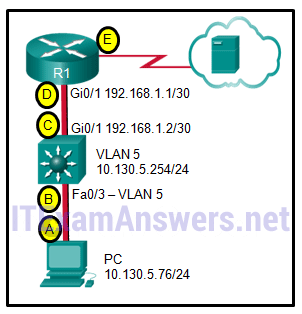
- point E
- point B
- point D
- point A
- point C
- No VLAN number is added to the frame in this design.
11. Fill in the blank.
In a Cisco switch, the extended range VLAN information is stored in the_____________file.
Correct Answer: running configuration
12. Which three actions can cause problems with a VTP implementation? (Choose three.)
- using a non-trunk link to connect switches
- using lowercase on one switch and uppercase on another switch for domain names
- not using any VTP passwords on any switches
- configuring all switches to be in VTP server mode
- using non-Cisco switches
- having a VTP transparent switch in between a VTP server switch and a VTP client switch (all switches in the same VTP domain)
13. Which two events will cause the VTP revision number on a VTP server to change? (Choose two.)
- changing the switch to a VTP client
- rebooting the switch
- changing interface VLAN designations
- adding VLANs
- changing the VTP domain name
14. On a Cisco switch, where is extended range VLAN information stored?
- running configuration file
- NVRAM
- startup configuration file
- flash
15. Refer to the exhibit. PC1 is unable to communicate with server 1. The network administrator issues the show interfaces trunk command to begin troubleshooting. What conclusion can be made based on the output of this command?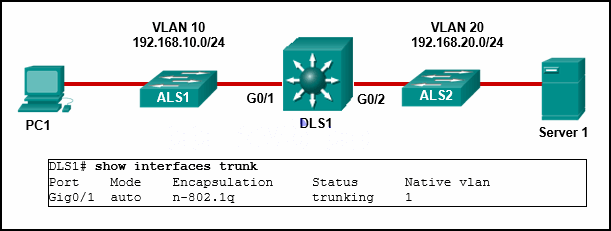
- Interface G0/2 is not configured as a trunk.
- The encapsulation on interface G0/1 is incorrect.
- VLAN 20 has not been created.
- The DTP mode is incorrectly set to dynamic auto on interface G0/1.
16. Refer to the exhibit. Communication between the VLANs is not occurring. What could be the issue?
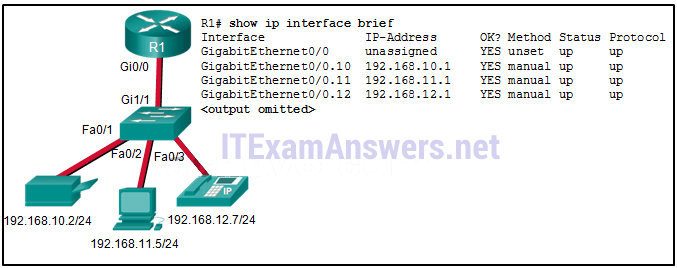
- A duplex issue exists between the switch and the router.
- Default gateways have not been configured for each VLAN.
- The wrong port on the router has been used.
- The Gi1/1 switch port is not in trunking mode.
17. Which two VTP parameters must be identical on all switches in the network in order to participate in the same VTP domain? (Choose two.)
- VTP transparent modeVTP server mode
- VTP domain password
- VTP client mode
- VTP domain name
- VTP revision number
18. What is a characteristic of VTP?
- Switches in VTP transparent mode revert back to VTP server mode after a reboot.
- Switches in VTP server mode cannot be updated by switches in VTP client mode.
- Switches in VTP transparent mode forward VTP advertisements.
- Switches in VTP client mode store VLAN information in NVRAM.
19. Under which two occasions should an administrator disable DTP while managing a local area network? (Choose two.)
- on links that should dynamically attempt trunking
- when connecting a Cisco switch to a non-Cisco switch
- when a neighbor switch uses a DTP mode of dynamic auto
- when a neighbor switch uses a DTP mode of dynamic desirable
- on links that should not be trunking
20. Refer to the exhibit. A network administrator is configuring inter-VLAN routing. However, the communication between VLAN 10 and VLAN 20 fails. Based on the output of the show vlan command, what is the cause of the problem?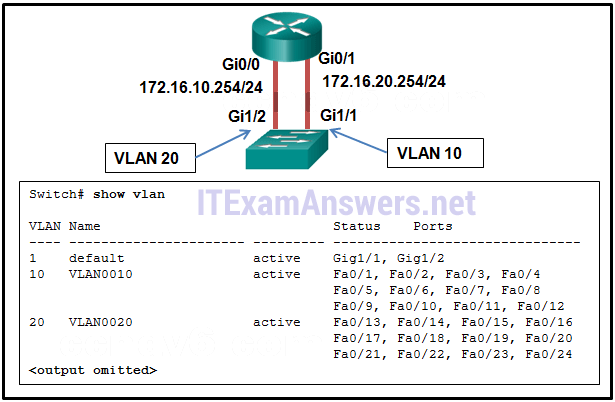
- Gi1/1 and Gi1/2 are not configured as trunk mode.
- The IP addresses on Gi0/0 and Gi0/1 are switched by mistake.
- The IP addresses on Gi0/0 and Gi0/1 are not on the same network.
- Gi1/1 and Gi1/2 are not assigned to their respective VLANs.
21. Open the PT Activity. Perform the tasks in the activity instructions and then answer the question. Fill in the blank. Do not use abbreviations.Which command is missing on the Layer 3 switch to restore the full connectivity between PC1 and the web server? (Note that typing no shutdown will not fix this problem.)
Correct Answer: ip address 192.168.20.1 255.255.255.0
22. How is traffic routed between multiple VLANs on a multilayer switch?
- Traffic is broadcast out all physical interfaces.
- Traffic is routed via internal VLAN interfaces.
- Traffic is routed via subinterfaces.
- Traffic is routed via physical interfaces.
23. Refer to the exhibit. A network administrator is verifying the configuration of inter-VLAN routing. Users complain that PC2 cannot communicate with PC1. Based on the output, what is the possible cause of the problem?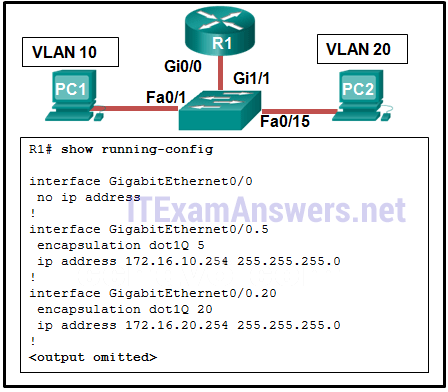
- The command interface GigabitEthernet0/0.5 was entered incorrectly.
- The no shutdown command is not entered on subinterfaces.
- There is no IP address configured on the interface Gi0/0.
- The encapsulation dot1Q 5 command contains the wrong VLAN.
- Gi0/0 is not configured as a trunk port.
24. Refer to the exhibit. A router-on-a-stick configuration was implemented for VLANs 15, 30, and 45, according to the show running-config command output. PCs on VLAN 45 that are using the 172.16.45.0 /24 network are having trouble connecting to PCs on VLAN 30 in the 172.16.30.0 /24 network. Which error is most likely causing this problem?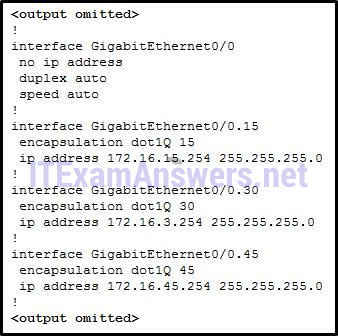
- There is an incorrect IP address configured on GigabitEthernet 0/0.30.
- The GigabitEthernet 0/0 interface is missing an IP address.
- The wrong VLAN has been configured on GigabitEthernet 0/0.45.
- The command no shutdown is missing on GigabitEthernet 0/0.30.
25. Refer to the exhibit. After attempting to enter the configuration that is shown in router RTA, an administrator receives an error and users on VLAN 20 report that they are unable to reach users on VLAN 30. What is causing the problem?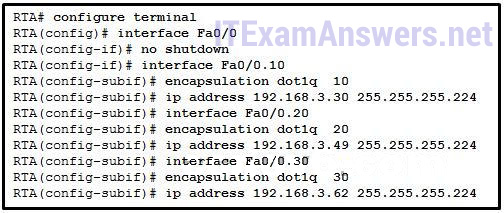
- RTA is using the same subnet for VLAN 20 and VLAN 30.
- There is no address on Fa0/0 to use as a default gateway.
- The no shutdown command should have been issued on Fa0/0.20 and Fa0/0.30.
- Dot1q does not support subinterfaces.
26. Which command displays the encapsulation type, the voice VLAN ID, and the access mode VLAN for the Fa0/1 interface?
- show interfaces trunk
- show mac address-table interface Fa0/1
- show vlan brief
- show interfaces Fa0/1 switchport
27. Question as presented: Match the DTP mode with its function. (Not all options are used.)

Older version
28. Which two network design features require Spanning Tree Protocol (STP) to ensure correct network operation? (Choose two.)
- static default routes
- implementing VLANs to contain broadcasts
- redundant links between Layer 2 switches
- link-state dynamic routing that provides redundant routes
- removing single points of failure with multiple Layer 2 switches
29. What is a characteristic of a Layer 2 loop?
- Broadcast frames are forwarded back to the sending switch.
- The Time-to-Live attribute of a frame is set to infinity.
- Routers continually forward packets to other routers.
- A switch is continually forwarding the same unicast frame.
30. What is the outcome of a Layer 2 broadcast storm?
- Routers will take over the forwarding of frames as switches become congested.
- New traffic is discarded by the switch because it is unable to be processed.
- CSMA/CD will cause each host to continue transmitting frames.
- ARP broadcast requests are returned to the transmitting host.
31. What additional information is contained in the 12-bit extended system ID of a BPDU?
- MAC address
- VLAN ID
- IP address
- port ID
32. Which three components are combined to form a bridge ID?
- port ID
- IP address
- extended system ID
- MAC address
- bridge priority
- cost
33. Which STP priority configuration would ensure that a switch would always be the root switch?
- spanning-tree vlan 10 priority 0
- spanning-tree vlan 10 priority 61440
- spanning-tree vlan 10 root primary
- spanning-tree vlan 10 priority 4096
34. Which protocol provides up to 16 instances of RSTP, combines many VLANs with the same physical and logical topology into a common RSTP instance, and provides support for PortFast, BPDU guard, BPDU filter, root guard, and loop guard?
- STP
- Rapid PVST+
- PVST+
- MST
35. Which two types of spanning tree protocols can cause suboptimal traffic flows because they assume only one spanning-tree instance for the entire bridged network? (Choose two.)
- STP
- Rapid PVST+
- PVST+
- MSTP
- RSTP
36. What is an advantage of PVST+?
- PVST+ requires fewer CPU cycles for all the switches in the network.
- PVST+ reduces bandwidth consumption compared to traditional implementations of STP that use CST.
- PVST+ optimizes performance on the network through autoselection of the root bridge.
- PVST+ optimizes performance on the network through load sharing.
37. In which two port states does a switch learn MAC addresses and process BPDUs in a PVST network? (Choose two.)
- blocking
- disabled
- forwarding
- learning
- listening
38. If no bridge priority is configured in PVST, which criteria is considered when electing the root bridge?
- lowest IP address
- lowest MAC address
- highest IP address
- highest MAC address
39. Which RSTP ports are connected to end devices?
- trunk ports
- designated ports
- root ports
- edge ports
40. A network administrator is preparing the implementation of Rapid PVST+ on a production network. How are the Rapid PVST+ link types determined on the switch interfaces?
- Link types are determined automatically.
- Link types must be configured with specific port configuration commands.
- Link types can only be determined if PortFast has been configured.
- Link types can only be configured on access ports configured with a single VLAN.
41. Which port state will switch ports immediately transition to when configured for PortFast?
- listening
- learning
- forwarding
- blocking
42. To obtain an overview of the spanning tree status of a switched network, a network engineer issues the show spanning-tree command on a switch. Which two items of information will this command display? (Choose two.)
- The root bridge BID.
- The role of the ports in all VLANs.
- The status of native VLAN ports.
- The number of broadcasts received on each root port.
- The IP address of the management VLAN interface.
43. What is the purpose of HSRP?
- It provides a continuous network connection when a router fails.
- It prevents a rogue switch from becoming the STP root.
- It enables an access port to immediately transition to the forwarding state.
- It prevents malicious hosts from connecting to trunk ports.
44. Which nonproprietary protocol provides router redundancy for a group of routers which support IPv4 LANs?
- HSRP
- VRRPv2
- GLBP
- SLB
45. Refer to the exhibit. Which protocol information is being displayed in the output?

- FHRP
- GLBP
- HSRP
- VRRP
46. Refer to the exhibit. A network engineer is troubleshooting host connectivity on a LAN that uses a first hop redundancy protocol. Which IPv4 gateway address should be configured on the host?

- 192.168.2.0
- 192.168.2.1
- 192.168.2.2
- 192.168.2.100
47. Fill in the blank. Do not use abbreviations.
The spanning-tree mode rapid-pvst global configuration command is used to enable Rapid PVST+.
48. Fill in the blank.
In FHRP operation, two or more routers are represented as a single virtual router.
49. What could be the effect of duplicate unicast frames arriving at a destination device due to multiple active alternative physical paths?
- Frame collisions increase.
- The number of broadcast domains increases.
- Application protocols malfunction.
- The number of collision domains increases.
50. Refer to the exhibit. Which trunk link will not forward any traffic after the root bridge election process is complete?
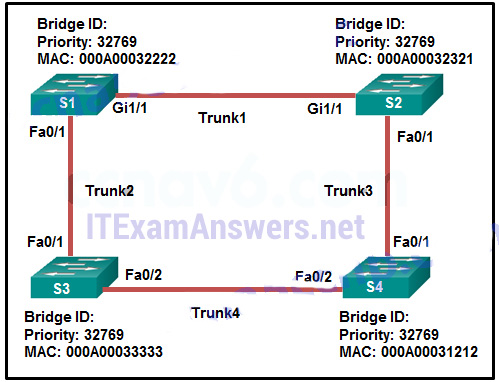
- Trunk1
- Trunk2
- Trunk3
- Trunk4
51. Which STP port role is adopted by a switch port if there is no other port with a lower cost to the root bridge?
- designated port
- root port
- alternate
- disabled port
52. Which is the default STP operation mode on Cisco Catalyst switches?
- RSTP
- PVST+
- MST
- MSTP
- Rapid PVST+
53. What value determines the root bridge when all switches connected by trunk links have default STP configurations?
- VLAN ID
- MAC address
- extended system ID
- bridge priority
54. Which two concepts relate to a switch port that is intended to have only end devices attached and intended never to be used to connect to another switch? (Choose two.)
- bridge ID
- edge port
- extended system ID
- PortFast
- PVST+
55. Which Cisco switch feature ensures that configured switch edge ports do not cause Layer 2 loops if a port is mistakenly connected to another switch?
- BPDU guard
- extended system ID
- PortFast
- PVST+
56. Refer to the exhibit. A network administrator configured routers R1 and R2 as part of HSRP group 1. After the routers have been reloaded, a user on Host1 complained of lack of connectivity to the Internet The network administrator issued the show standby brief command on both routers to verify the HSRP operations. In addition, the administrator observed the ARP table on Host1. Which entry should be seen in the ARP table on Host1 in order to gain connectivity to the Internet?
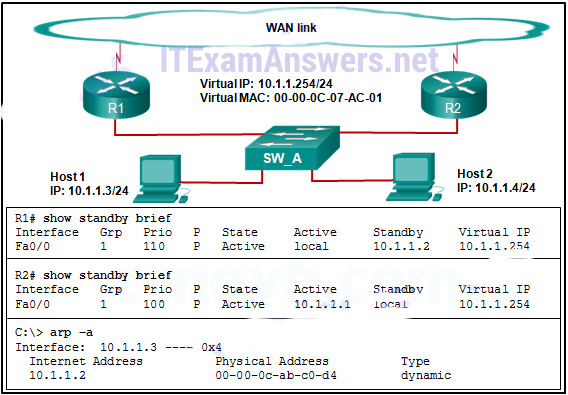
- the IP address and the MAC address of R1
- the virtual IP address and the virtual MAC address for the HSRP group 1
- the virtual IP address of the HSRP group 1 and the MAC address of R1
- the virtual IP address of the HSRP group 1 and the MAC address of R2
57. Fill in the blank. Do not abbreviate.
To enable Rapid PVST+ on a Cisco switch, the spanning-tree mode rapid-pvst global configuration mode command is required
58. Fill in the blank. Use a number.
The default hello timer value for STP BPDU frames is 2 seconds.
59. Launch PT. Hide and Save PT
Open the PT Activity. Perform the tasks in the activity instructions and then answer the question.
Which switch is the root bridge?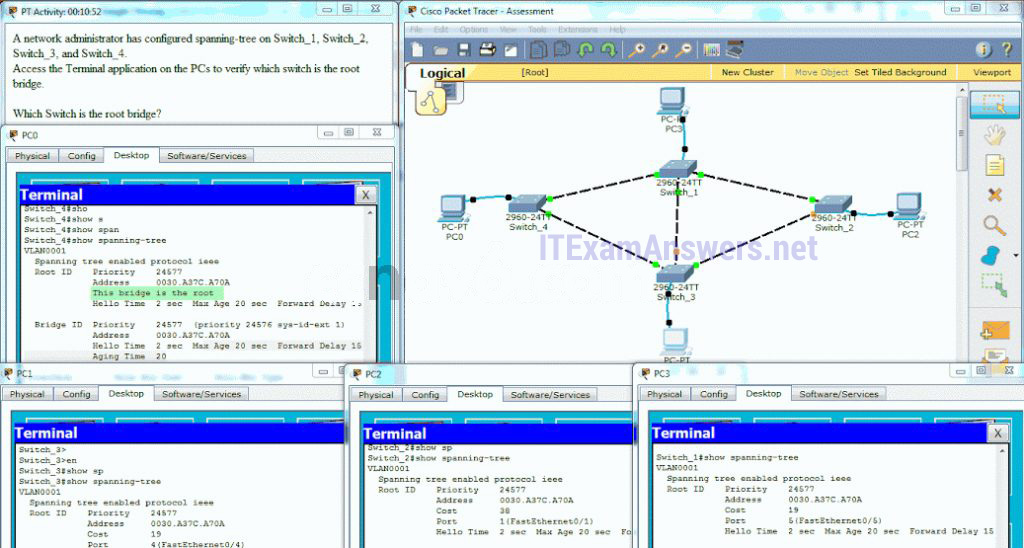
- Switch_1
- Switch_2
- Switch_4
- Switch_3
60. Match the step number to the sequence of stages that occur during the HSRP failover process.
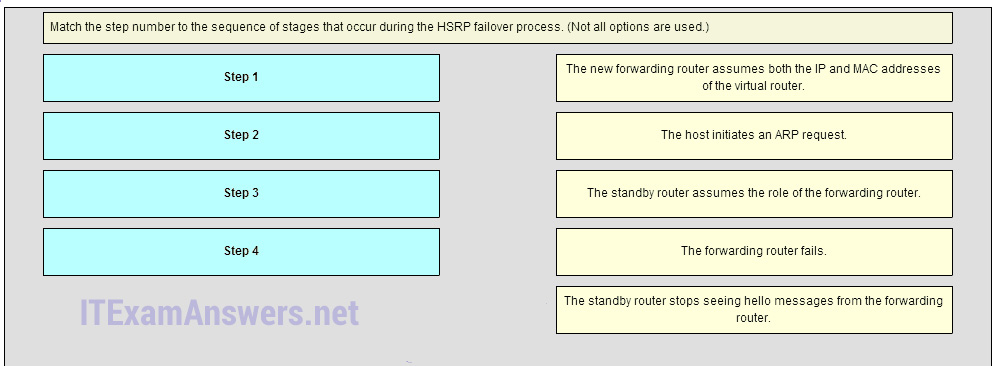
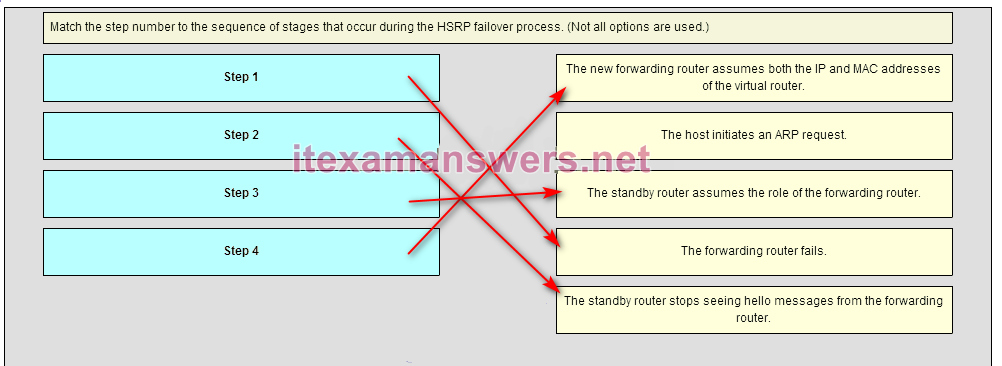
Place the options in the following order:
The new forwarding router assumes both the IP and MAC address of the virtual router. -> Step 4
– not scored –
The standby router assumes the role of the forwarding router. -> Step 3
The forwarding router fails. -> Step 1
The standby router stops seeing hello messages from the forwarding router. -> Step 2
61. Match the spanning-tree feature with the protocol type. (Not all options are used.)

Place the options in the following order:
Cisco implementation of IEEE 802.1D ==> PVST+
Fast converging enhancement of IEEE 802.1D ==> RSTP
IEEE standard that reduces the number of STP instances ==+> MSTP
– not scored ==> MST
Proprietary per VLAN implementation of IEEE 802.1w ==> Rapid PVST+

Which three statements about routed ports on a multilayer switch are true?
1. A routed port can support VLAN subinterfaces. 2. A routed port takes an IP address assignment. 3. A routed port can be configured with routing protocols. 4. A routed port is a virtual interface on the multilayer switch. 5. A routed port is associated only with one VLAN. 6. A routed port is a physical interface on the multilayer swi
Thanks
I passed CCNA, make mistakes, study hard and good resources. Thanks so much.
Refer to the exhibit. A network administrator is configuring inter-VLAN routing. However, the communication between VLAN 10 and VLAN 20 fails. Based on the output of the show vlan command, what is the cause of the problem?
Answer is: Gi1/1 and Gi1/2 are not assigned to their respective VLANs
Thanks you!